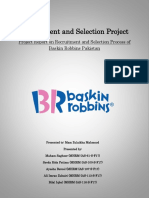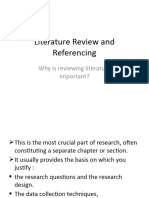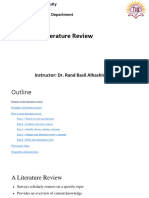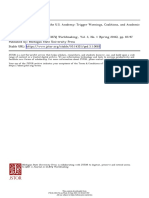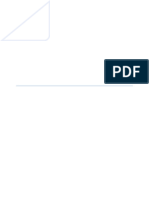Literature Review AY
Literature Review AY
Uploaded by
Ahmad YanCopyright:
Available Formats
Literature Review AY
Literature Review AY
Uploaded by
Ahmad YanOriginal Description:
Copyright
Available Formats
Share this document
Did you find this document useful?
Is this content inappropriate?
Copyright:
Available Formats
Literature Review AY
Literature Review AY
Uploaded by
Ahmad YanCopyright:
Available Formats
The Critical Literature Review
Q: What is a literature review?
Stated most simply, it is an overview of published and unpublished materials which help
answer two fundamental questions:
1. What are the current theoretical or policy issues and debates related to your topic?
2. What is the current state of knowledge about these issues and problems?
Q: Why do a review of the literature?
1. As a way to frame and focus a research project
• When research questions are formed without sustained reference to the literature,
the study is likely to be marred by
1. Naïve research instruments that lack conceptual underpinnings
2. Problems with sense-making because the researcher is not alert to themes
that may be identifiable
3. Problems with claims-making because the researcher lacks the knowledge to
state its significance for theory, policy or practice.
• Knowledge of the literature can help:
1. Tighten research questions
2. Enhance conceptual sensitivity
3. Provide a source for making comparisons
4. Provide a cache of descriptive data
5. Provide questions for initial observations and interviews
6. Stimulate questions during the analysis
7. Suggest areas for theoretical sampling
8. Confirm findings, or, findings can be used to show where current literature is
incorrect, simplistic, or partial
9. Model ways of making claims about the possible significance of your work
2. As a way to justify a research project to stakeholders
• Although ideas for the research topic can come from anywhere (including biography or
personal interest), the purpose and significance of the research and its relevance are
generally established through showing its place in what is already known about the
subject.
• Particularly if you are writing a proposal, the way you justify the purpose and
significance of your research project to funding sources, committees, and other
gatekeepers is by critically reviewing the published literature on your topic and showing
how the proposed research will contribute to the conversation.
Types of Literature and Types of Literature Reviews
• In general, the literature can be divided into four substantive categories:
1. Topical literature relevant to the subject matter of the research
2. Theoretical literature relevant to concepts and theoretical frameworks
3. Methodological literature relevant to strategies of data collection and analysis
4. Policy literature relevant to the implementation and effectiveness of
interventions
• Although these categories of literature are potentially relevant to any research subject,
the goals and purposes of the research should determine which are useful to any
particular research project.
• Although the theoretical and methodological literature can generally be found in
published books and articles, the topical and policy literature is scattered more widely in
the so-called “gray literature” which can include foundation reports, conference
proceedings, dissertations, magazines, etc., as well as in government reports and
statistical sources. Naturally, these sources require much greater effort to uncover and
are harder to review in a systematic way.
• Not all literature reviews are the same or conducted for the same purpose. Table 2.1 in
Petticrew & Roberts contains a useful overview. The scope and types of literature
discussed and the way they are reviewed (summarized or presented more critically, for
example) depends upon the intended use of the review.
In the context of field studies, remember that an overreliance on the literature can stifle
creativity and may produce an overly deductive approach.
Let the literature guide you, not rule you.
Tips on doing a critical literature review
Finding usable literature:
• Browse discipline-specific or area-specific reviews (Annual Review of Sociology, etc.)
• Look through past several years of flagship journals
• Use key terms to search electronic databases
• Limit yourself to 10 or so items to actually review (varies by project of course), only
about half of which you will actually read properly.
Reviewing the literature:
• Don’t just summarize the studies, evaluate them (but don’t be too dismissive)
• Look for key themes and issues running through them
• Take a holistic view of the relevant literature to provide an overview of what it says
• Pay attention to the utility of qualitative research methods to address key themes and
issues
Remember, the literature review is part of the research process. Like data collection and
analysis, it should be systematic and thorough.
You might also like
- Against Sadomasochism - A Radical Feminist Analysis PDFDocument110 pagesAgainst Sadomasochism - A Radical Feminist Analysis PDFSotiria KalabalikiNo ratings yet
- Schools Division of Tarlac ProvinceDocument4 pagesSchools Division of Tarlac ProvinceDonny BuenoNo ratings yet
- Coursework-Literature Review: Dr. Ajai Kumar Jain PHD, M.Phil, Mba, LLB, MbbsDocument47 pagesCoursework-Literature Review: Dr. Ajai Kumar Jain PHD, M.Phil, Mba, LLB, MbbsRashmi KanungoNo ratings yet
- Levinas - Phenomenology of ErosDocument13 pagesLevinas - Phenomenology of ErosJason CieplyNo ratings yet
- R&S Process of Baskin and RobbinsDocument8 pagesR&S Process of Baskin and RobbinsAli Imran ZubairiNo ratings yet
- Process Skills DefinedDocument3 pagesProcess Skills DefinedEka PrastiyantoNo ratings yet
- Lecture 4 (Ii) The Literature ReviewDocument27 pagesLecture 4 (Ii) The Literature ReviewNeha MunneeNo ratings yet
- Literature Review InterpretingDocument8 pagesLiterature Review InterpretingKawtarNo ratings yet
- Lecture 9 Research ProcessDocument23 pagesLecture 9 Research Processhamza najmNo ratings yet
- Presentation 4Document27 pagesPresentation 4mbuyelo455No ratings yet
- Literature ReviewDocument25 pagesLiterature ReviewTemesgen ErenaNo ratings yet
- lESSON 6Document17 pageslESSON 6Umaralieva MunojatNo ratings yet
- Literature ReviewDocument25 pagesLiterature ReviewandersonmapfirakupaNo ratings yet
- Literature Review CimDocument38 pagesLiterature Review CimOmosa Elijah MochamaNo ratings yet
- Literature ReviewDocument5 pagesLiterature ReviewAjit YadavNo ratings yet
- The Literature Review 2019Document30 pagesThe Literature Review 2019Dari ThangkhiewNo ratings yet
- Literature ReviewDocument19 pagesLiterature ReviewMagda EslamNo ratings yet
- Chapter II. RRLDocument37 pagesChapter II. RRLjerry jerryNo ratings yet
- Review of RRL2Document40 pagesReview of RRL2JohnmarvinDalupangDelaCruzNo ratings yet
- Doing Literature ReviewDocument11 pagesDoing Literature ReviewSky LelouchNo ratings yet
- RMT4 - Problem IdentificationDocument48 pagesRMT4 - Problem IdentificationkemalNo ratings yet
- M4 Tinjauan LiteraturDocument42 pagesM4 Tinjauan LiteraturTHANESWARI A/P SUPPARAO MoeNo ratings yet
- Conducting and Writing: Literature ReviewDocument36 pagesConducting and Writing: Literature Reviewleserdrac333No ratings yet
- Review of LitDocument38 pagesReview of Litnnnn hhhhNo ratings yet
- Chapter 3 - How To Write A Literature Review Guide, Examples, & TemplatesDocument36 pagesChapter 3 - How To Write A Literature Review Guide, Examples, & Templatesb.requillo.488849No ratings yet
- 5 - Review of Related LiteratureDocument18 pages5 - Review of Related Literaturestephaniecaronan15No ratings yet
- Paper GuidelineDocument8 pagesPaper GuidelinechanchunsumbrianNo ratings yet
- Literature ReviewDocument51 pagesLiterature Reviewየማርያም ልጅ ነኝNo ratings yet
- Reviewing Literature: Why Write A Literature Review?Document5 pagesReviewing Literature: Why Write A Literature Review?OMARSINNo ratings yet
- Unit II Review of Literature and Theoretical Framework in ResearchDocument38 pagesUnit II Review of Literature and Theoretical Framework in Researchshitu.tirsitNo ratings yet
- RMI Unit-2 (1)Document24 pagesRMI Unit-2 (1)harshithashetty188No ratings yet
- Unit 1. Selection of TopicDocument27 pagesUnit 1. Selection of Topicrajatsharma.sdsNo ratings yet
- Literature Review 1Document5 pagesLiterature Review 1cb.bikash2003No ratings yet
- REPORT Review of Related LiteratureDocument66 pagesREPORT Review of Related Literaturelemi celemenNo ratings yet
- Research Methodology-and-publication-ethics-2024-pdf-fileDocument30 pagesResearch Methodology-and-publication-ethics-2024-pdf-file.aju12.No ratings yet
- Chapter Three: Review of Literature in ResearchDocument41 pagesChapter Three: Review of Literature in ResearchAliyan AmanNo ratings yet
- Lecture 4 Literature ReviewDocument16 pagesLecture 4 Literature ReviewABDULSWAMADU KARIMUNo ratings yet
- Lecture 3 (Unit1) - Review of LiteratureDocument19 pagesLecture 3 (Unit1) - Review of LiteratureMohit JangidNo ratings yet
- Annotated Bibliography - Organizing Your Social Sciences Research Paper - Research Guides at University of Southern CaliforniaDocument5 pagesAnnotated Bibliography - Organizing Your Social Sciences Research Paper - Research Guides at University of Southern CaliforniaFajarAminullahNo ratings yet
- Lesson 3: Learning From Others and Reviewing The LiteratureDocument5 pagesLesson 3: Learning From Others and Reviewing The LiteratureClaireSobredilla-JuarezNo ratings yet
- LITERATURE REVIEW MethodsDocument21 pagesLITERATURE REVIEW MethodsJSPNo ratings yet
- Chapter 4 (Review of Literature)Document51 pagesChapter 4 (Review of Literature)natnael haileNo ratings yet
- Learning From Others and Reviewing The Literature: Practical Research 1 Quarter 3 - Week 5Document4 pagesLearning From Others and Reviewing The Literature: Practical Research 1 Quarter 3 - Week 5Jhude JosephNo ratings yet
- Literature Review: Politeknik Negeri Semarang 2018Document58 pagesLiterature Review: Politeknik Negeri Semarang 2018Ardi JunNo ratings yet
- Literature Review 1580730958563Document22 pagesLiterature Review 1580730958563Rahul RSNo ratings yet
- Unit-II Literature ReviewDocument23 pagesUnit-II Literature Reviewparameshwari pNo ratings yet
- Q2week1 Literature-ReviewDocument24 pagesQ2week1 Literature-Reviewmiguelaldrincabrera07No ratings yet
- RM Chapter 2Document65 pagesRM Chapter 2IramfatimaNo ratings yet
- 2a. REVIEW OF LTERATUREDocument36 pages2a. REVIEW OF LTERATUREELLAINE DE CLARO100% (1)
- Research - Literature ReviewDocument42 pagesResearch - Literature ReviewHamiduNo ratings yet
- Chapter 3Document15 pagesChapter 3RXDoomNo ratings yet
- Reading On Related StudiesDocument24 pagesReading On Related Studiesraylinecastro21No ratings yet
- Week 9 Research in Hospitality Industry: Review of Related Literature and StudiesDocument21 pagesWeek 9 Research in Hospitality Industry: Review of Related Literature and StudiesNESTOR TRABALLONo ratings yet
- Module 3Document21 pagesModule 3Jhezmae rose AlonzoNo ratings yet
- Chapter IVDocument24 pagesChapter IVbirhanukifle10No ratings yet
- Literature ReviewDocument15 pagesLiterature ReviewArshiaNo ratings yet
- The Literature ReviewDocument22 pagesThe Literature ReviewParvineeNo ratings yet
- Students Research Guide 1Document3 pagesStudents Research Guide 1jibran khanNo ratings yet
- Literature ReviewDocument11 pagesLiterature Reviewfayyazmodi50% (2)
- What Headings Should Be Included in A Literature ReviewDocument8 pagesWhat Headings Should Be Included in A Literature Reviewc5rr5sqwNo ratings yet
- Unit 1 - Lecture 7-8 - Literature ReviewDocument37 pagesUnit 1 - Lecture 7-8 - Literature ReviewPradip Kumar YadavNo ratings yet
- Literature ReviewsDocument4 pagesLiterature ReviewsLung'waga Nsab'o NkuneNo ratings yet
- WEEK 2 Review of Related LiteratureDocument44 pagesWEEK 2 Review of Related LiteratureCamille Precious LalagunaNo ratings yet
- University of Lucknow: 4 Semester AssignmentDocument8 pagesUniversity of Lucknow: 4 Semester AssignmentAtul AnandNo ratings yet
- How to Successfully Deal with Your Dissertation DataFrom EverandHow to Successfully Deal with Your Dissertation DataNo ratings yet
- Mindfulness ExcercisesDocument13 pagesMindfulness ExcercisesKelli SprowlsNo ratings yet
- What Are The Problems and Why Do They Exist?Document4 pagesWhat Are The Problems and Why Do They Exist?Stephen OndiekNo ratings yet
- DLL Mathematics 4 q3 w1Document4 pagesDLL Mathematics 4 q3 w1YolydeBelenNo ratings yet
- Bailey - Confession and Catharsis in The U.S. Academy - Trigger Warnings, Coalitions, and Academic AudiencesDocument16 pagesBailey - Confession and Catharsis in The U.S. Academy - Trigger Warnings, Coalitions, and Academic AudiencesOnur Can SümenNo ratings yet
- English 5 q4Document6 pagesEnglish 5 q4Lemuel MoradaNo ratings yet
- Band Form 5Document6 pagesBand Form 5NOR AZMAZIHA BT HUSSEIN MoeNo ratings yet
- Hmpyc80 Assignment 3 2023Document10 pagesHmpyc80 Assignment 3 2023CHAZ CHUMANo ratings yet
- What Is Organizational CommunicationDocument6 pagesWhat Is Organizational Communicationعبد الرحيم فاطميNo ratings yet
- Multimodal Deep LearningDocument21 pagesMultimodal Deep Learningsagnik ghosalNo ratings yet
- 22 Highly-Effective Bar Exam Tips PDFDocument7 pages22 Highly-Effective Bar Exam Tips PDFMark Christian B. ApordoNo ratings yet
- Ajzen, I., & Fishbein, M. (1970) - The Prediction of Behavior From Attitudinal and Normative VariablesDocument22 pagesAjzen, I., & Fishbein, M. (1970) - The Prediction of Behavior From Attitudinal and Normative VariablesRen SuzakuNo ratings yet
- Ang Buod NG Ibong AdarnaDocument2 pagesAng Buod NG Ibong AdarnaMarian Dacara GaliciaNo ratings yet
- Detailed Lesson Plan (DLP) Format: Instructional PlanningDocument11 pagesDetailed Lesson Plan (DLP) Format: Instructional PlanningGlenda PapelleroNo ratings yet
- Celebration HistoryDocument25 pagesCelebration HistoryD DurbNo ratings yet
- Diu Lei Lou Mou Chau HaiDocument1 pageDiu Lei Lou Mou Chau HaiChoong Cheng LounNo ratings yet
- UCSP LP Lesson 4 Definition Characteristics of CultureDocument2 pagesUCSP LP Lesson 4 Definition Characteristics of CultureApple Biacon-Cahanap100% (2)
- Factors Influencing Disclosure of Domestic Violence Student's Name Institutional Affiliation Course DateDocument8 pagesFactors Influencing Disclosure of Domestic Violence Student's Name Institutional Affiliation Course DateMasila JohnNo ratings yet
- Intergroup Conflicts and Negotiations: John M. Ivancevich Michael T. MattesonDocument19 pagesIntergroup Conflicts and Negotiations: John M. Ivancevich Michael T. Mattesondharshn12345No ratings yet
- ENG502 Highlight Handouts by Mudasar QureshiDocument68 pagesENG502 Highlight Handouts by Mudasar Qureshilarkiziddi817No ratings yet
- Arden, M. (1997) - Unconscious Logic. An Introduction To Matte Blanco's Bi-Logic and Its UsesDocument3 pagesArden, M. (1997) - Unconscious Logic. An Introduction To Matte Blanco's Bi-Logic and Its UsesofanimenochNo ratings yet
- A Presentation On: Personality DevelopmentDocument22 pagesA Presentation On: Personality Developmentrocking009No ratings yet
- DLL-Week-1 HGDocument5 pagesDLL-Week-1 HGTRICIA DIZONNo ratings yet
- G11 - Characteristics, Processes, and Ethics of ResearchDocument16 pagesG11 - Characteristics, Processes, and Ethics of Researchsoru riiruNo ratings yet
- When I Heard The Learn'd Astronomer by Walt WhitmanDocument1 pageWhen I Heard The Learn'd Astronomer by Walt WhitmanDhesta Maydiana SariNo ratings yet
- Media Literacy - EgyanDocument15 pagesMedia Literacy - EgyanDinamani SinghNo ratings yet




